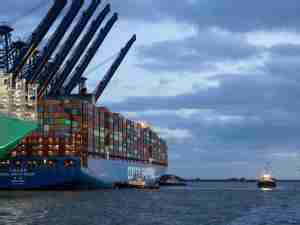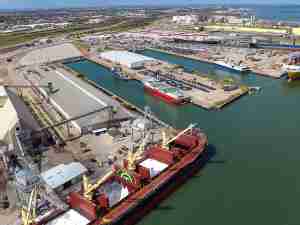Fitch Ratings has affirmed the 'A' rating on the Jacksonville Port Authority Florida's (JaxPort or the port) approximately $129.8 million in outstanding revenue bonds. The Rating Outlook is Stable.
RATING RATIONALE
The rating reflects JaxPort's versatile financial and operating position even in light of volatility stemming from the coronavirus pandemic. The rating also reflects the port's historically stable performance anchored by growing automobile and container activity in conjunction with sizable contractually guaranteed revenues from existing long-term container and cargo tenants. In addition, the rating is further supported by the port's diverse revenue base and desirable location in the Southeast Atlantic Region, providing greater access to cargo and cruise activities as well as Latin American and Caribbean markets. The port's financial metrics under Fitch's current coronavirus-driven scenario remain resilient with all-in coverage averaging 1.8x, and leverage reaching under 5x by 2024.
KEY RATING DRIVERS
Strategically Located South-Eastern Port - Revenue Risk (Volume): Midrange
The port benefits from a desirable location with improving intermodal connectivity and infrastructure that helps maintain its niche importance in the international automobile trade. Container (50% of operations) and automobile (30% of operations) businesses represent the port's largest operations, and have grown quickly over the past decade to reach record levels. While Asian container trade is the port's fastest growing segment, the port is somewhat insulated from shifting trade policies with China and, more recently, volume volatility due to the coronavirus impacts, having just 8% of containers attributable to China. Nevertheless, JaxPort operates in the highly competitive Southeast Atlantic region for cargo and cruise activities, with moderate trade exposure to Latin America and Caribbean markets.
Diversified Revenue Base with Contracted Tenants - Revenue Risk (Price): Midrange
The port's increasingly diverse revenue base has experienced healthy growth over the past five years. JaxPort serves as a landlord port with approximately half of its operating revenues derived from long-term leases with minimum annual guarantee (MAGs) terms from a diverse group of tenants, including automobile, break-bulk, bulk and cruise, which helps to mitigate cargo volatility. Additionally, exposure to cruise operations is minimal and represents just 8% of total port revenues. New services and extended agreements with previous tenants provide revenue protection for the port, though some renewed contracts are shorter, between one year and five years.
Adequate Facilities with Future Needs - Infrastructure Development and Renewal: Midrange
The port's five-year (2020-2024) capital improvement plan (CIP) includes wharf rehabilitation projects, tenant leasehold improvements, portions of a major harbor deepening project, and related berth projects. The harbor deepening project began in early 2018 and is anticipated to cost $137.8 million over the next five years. Much of the project's funding will be provided by federal, state, and local grants, as well as port operating cash flow. Excluding the harbor deepening project, the total CIP is manageable at $191.1 million. No adjustments to the port's CIP timing are anticipated at this time due to the coronavirus, but the authority maintains flexibility with the option to defer projects as needed.
Strong Debt Profile - Debt Structure: Stronger
Senior lien debt is fixed rate and fully amortizing. The port holds roughly $140 million in various unrated obligations. The debt service reserve fund (DSRF) is 100% cash funded and the overall debt service profile is flat to declining. The port also benefits from steadily growing unrestricted liquidity, which could serve as further cushion for debt obligations in the event of a near term decline in operations.
Financial Profile
The port has seen growing revenues in recent years, leading to all-in DSCRs above 1.5x historically and is expected to remain above 1.2x under Fitch's rating case and downside scenarios, even when considering the effects of coronavirus-related declines. Near-term aggregate leverage is elevated compared with peers, but is expected to step down quickly and reach below 5.0x by 2024. The port also benefits from MAGs in excess of senior debt service requirements and pledged intergovernmental revenue transfers from the city of Jacksonville. Coverage could potentially increase in future years when city debt drops off, increasing residual interlocal revenues.
PEER GROUP
JaxPort's peers include other 'A'-rated Florida ports, including Broward County (Port Everglades; A/Negative) and Hillsborough County Port District (Tampa Port Authority; A/Stable). Tampa has diverse business operations with contracted revenues similar to JaxPort, while Port Everglades is more reliant on cruise revenues. All benefit from MAGs covering the majority of operating revenues. Port Everglades' aggregate coverage is comparable with that of JaxPort, while Tampa's coverage is slightly lower. Both peers have materially lower leverage and higher liquidity than JaxPort.
RATING SENSITIVITIES
Factors that could, individually or collectively, lead to positive rating action/upgrade:
- Positive rating migration is unlikely at this time given the port's sizable near-term leverage position relative to peers.
Factors that could, individually or collectively, lead to negative rating action/downgrade:
- Substantial additional borrowings or a rising expense profile, which result in sustained consolidated coverage below 1.6x or leverage above 6.0x could lead to a downgrade.

_-_28de80_-_939128c573a41e7660e286f3686f2a6e25686350_yes.jpg)








